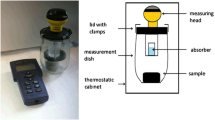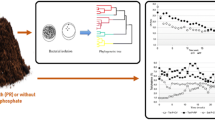Abstract
Biphasic composts were prepared by first mixing peat moss and sawdust with a nitrogen-rich biomass such as chitinous waste or cow manure and composting them until termination of the thermophilic phase. These partially stabilized composts were then amended with shrimp waste inducing a second thermophilic phase. Filter-sterilized water extracts obtained from two mature biphasic composts (SP2W2+S and MPW+S) reduced the growth of two oomycete plant pathogens, Phytophthora fragariae var. rubi and Pythium ultimum. Both SP2W2+S and MPW+S composts significantly reduce the incidence of cucumber damping-off caused by Pythium ultimum as compared to a commercial brand of compost made from shrimp waste and peat moss. Hydrolysis products of chitin were unlikely to be responsible for growth inhibition since no oligomeric forms of chitin were detected in SP2W2+S. The shrimp waste amendment carried out after the first thermophilic phase modified the microbial populations of biphasic composts. Following the amendment, the proportion of branched-chain microbial fatty acids typical of Gram-positive bacteria increased considerably suggesting that this group of bacteria became more prevalent within the total microbial population. These data suggests that the two-phase composting process promotes the proliferation of Gram-positive bacteria antagonistic to oomycete plant pathogens.
Similar content being viewed by others
References
Alvarez M A D, Gagné S and Antoun H 1995 Effect of compost on rhizosphere microflora of the tomato and on the incidence of plant growth-promoting rhizobacteria. Appl. Environ. Microbiol. 61, 194–199.
Ben-Yephet Y and Nelson E B 1999 Differential suppression of damping-off caused by Pythium aphanidermatum, P. irregulare and P. myriotylum in composts at different temperatures.Plant Dis. 83, 556–560.
Bligh E G and Dyer W J 1959 A rapid method of total lipid extraction and purification. Can. J. Biochem. Physiol. 37, 911–917.
Bureau de normalisation du Québec 1996 Amendements organiques-composts. Canadian National Standards CAN/BNQ 0413–200.
Craft C M and Nelson E B 1996 Microbial properties of composts that suppress damping-off and root rot of creeping bentgrass caused by Pythium graminicola. Appl. Environ. Microbiol. 62, 1550–1557.
Crawford D L, Lynch J M, Whipps J M and Ousley M A 1993 Isolation and characterization of antagonists of a fungal root pathogen. Appl. Environ. Microbiol. 59, 3899–3905.
Cronin M J, Yohalem D S, Harris R F and Andrews J H 1996 Putative mechanisms and dynamics of inhibition of the apple scab pathogen Venturia inequalis by compost extracts. Soil Biol. Biochem. 28, 1241–1249.
De Ceuster T J J and Hoitink H A J 1999a Using compost to control plant diseases. BioCycle 40, 61-64.
De Ceuster T J J and Hoitink H A J 1999b Prospects for composts and biocontrol agents as substitutes for methyl bromide in biological control of plant diseases. Compost Sci. Utilization 7, 6–15.
Emmert E A B and Handelsman J H 1999 Biocontrol of plant disease: a (Gram-) positive perspective. FEMS Microbiol. Lett. 171, 1–9.
Fiddaman P J and Rossall S 1994 Effect of substrate on the production of antifungal volatiles from Bacillus subtilis. J. Appl. Bacteriol. 76, 394–405.
Handelsman, J, Raffel S, Mester E H, Wunderlich L and Grau C R 1990 Biological control of damping-off of alfalfa seedlings with Bacillus cereus UW85. Appl. Environ. Microbiol. 56, 713–718.
Hoitink H A J, Chen W, Trillas-Gay M I and Chung Y R 1987 Compost for control of plant disease. In Compost: Production, Quality and Use. Eds. M De Bertoldi, MP Ferranti, P L'Hermite and F Zucconi. pp 414–419. Elsevier Applied Science, London.
Houtin J A, Karam A, Parent L É and Isfan D 1995 Effect of peat moss-shrimp wastes compost on the growth of barley (Hordeum vulgare L.) on a loamy sand soil. Comm. Soil Sci. Plant Anal. 26, 3275–3289.
Kendra D F and Hadwiger L A 1984 Characterization of smallest chitosan oligomer that is maximally antifungal to Fusarium solani and elicits pisatin formation in Pisum sativum. Exp. Mycol. 8, 276–281.
Kim K D, Nemec S and Musson G 1997 Control of Phytophthora root rot and crown rot of bell pepper with composts and soil amendment in the greenhouse. Appl. Soil Ecol. 5, 169–179.
Labrie C 1998 Recherche sur les propriétés phytoprotectrices de composts de résidus chitineux. M.Sc. thesis, Université de Sherbrooke, Sherbrooke, Canada. 76 p.
Mathur S P, Daigle J-Y, Brooks J L, Lévesque M and Arsenault J 1988 Composting seafood wastes. BioCycle 29, 44–49.
Miller L T 1982 Single derivatization method for routine analysis of bacterial whole-cell fatty acid methyl esters, including hydroxy acids. J. Clin. Microbiol. 16, 584–586.
Pennanen T, Frostegard A, Fritze H and Baath E 1996 Phospholipid fatty acid composition and heavy metal tolerance of soil communities along two heavy metal-polluted gradients in coniferous forests. Appl. Environ. Microbiol. 62, 420–428.
Reissig J L, Strominger J L and Leloir L F 1955 A modified colorimetric method for the estimation of N-acetylaminosugars. J. Biol. Chem. 217, 959–966.
Roy S, Leclerc P, Auger F, Soucy G, Moresoli C, Côté L, Potvin D, Beaulieu C and Brzezinski R 1997 A novel two-phase composting process using shrimp shells as an amendment to partly composted biomass. Compost Sci. Utilization 5, 52–64.
Steffan R J and Atlas R M 1988 DNA amplification to enhance detection of genetically engineered bacteria in environmental samples. Appl. Environ. Microbiol. 54, 2185–2191.
Strohl W R 1997 Industrial antibiotics: today and the future. In Biotechnology of Antibiotics. Ed. WR Strohl. pp 1–47. Marcel Dekker Inc., New York.
Sutherland E D and Papavizas G C 1991 Evaluation of oospore hyperparasites for the control of Phytophthora crown rot of pepper. J. Phytopathol. 131, 33–39.
Suzuki K 1988 Cellular fatty acid analysis in actinomycete taxonomy. In Biology of Actinomycetes' 88. Eds. Okami, T Beppu and H Ogawara. pp 251–256. Japan Scientific Socities Press, Tokyo.
Theodore M and Toribio J A 1995 Suppression of Pythium aphanidermatum in composts prepared from sugarcane factory residues. Plant Soil 177, 219–223.
Toussaint V, Valois D, Dodier M, Faucher E, Déry C, Brzezinski R, Ruest L and Beaulieu C 1997 Characterization of actinomycetes antagonistic to Phytophthora fragariae var. rubi. Phytoprotection 78, 43–51.
Valois D, Fayad K, Barasubiye T, Garon M, Déry C, Brzezinski R and Beaulieu C 1996 Glucanolytic actinomycetes antagonistic to Phytophthora fragariae var. rubi, the causal agent of raspberry root rot. Appl. Environ. Microbiol. 62, 1630–1635.
Zhang W, Han D Y, Dick W A, Davis K R and Hoitink H A J 1998 Compost and compost water extract-induced systematic acquired resistance in cucumber and Arabidopsis. Phytopathology 88, 450–455.
Author information
Authors and Affiliations
Corresponding author
Rights and permissions
About this article
Cite this article
Labrie, C., Leclerc, P., Côté, N. et al. Effect of chitin waste-based composts produced by two-phase composting on two oomycete plant pathogens. Plant and Soil 235, 27–34 (2001). https://doi.org/10.1023/A:1011807513547
Issue Date:
DOI: https://doi.org/10.1023/A:1011807513547




